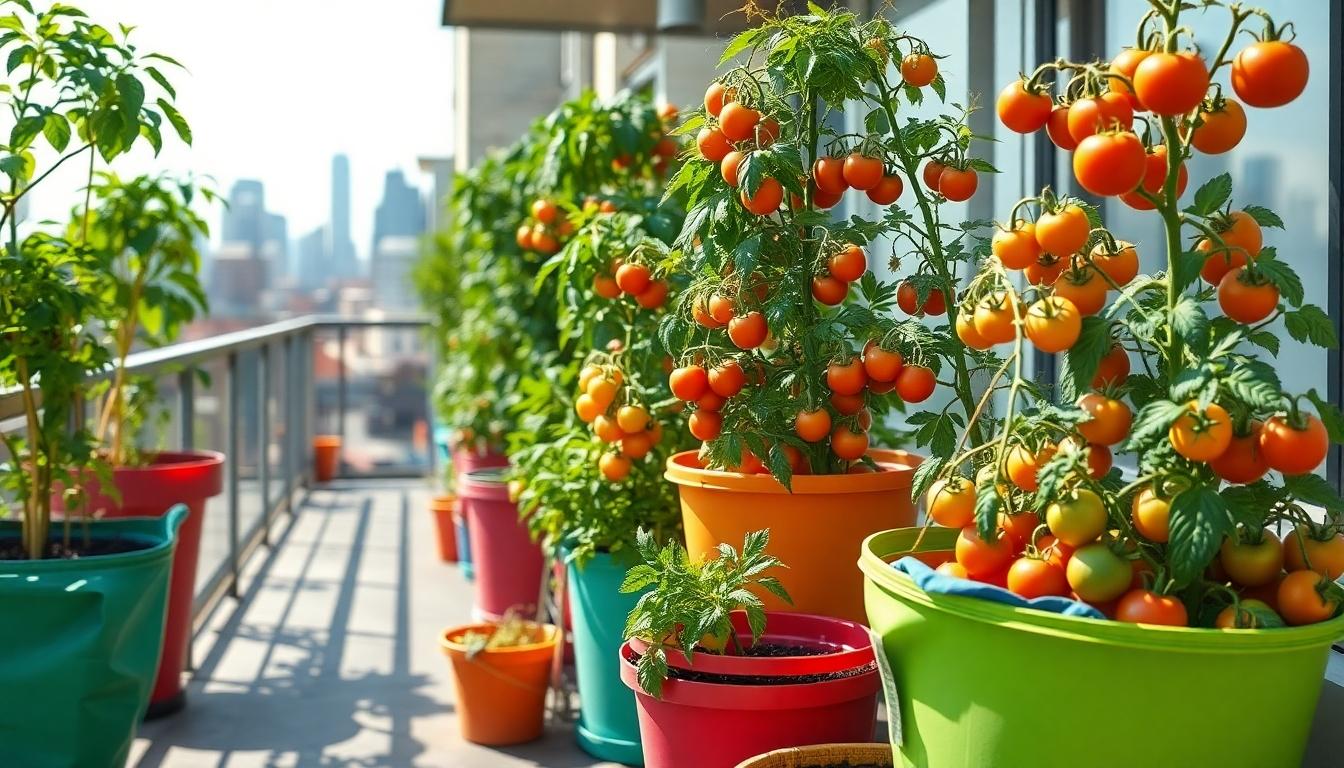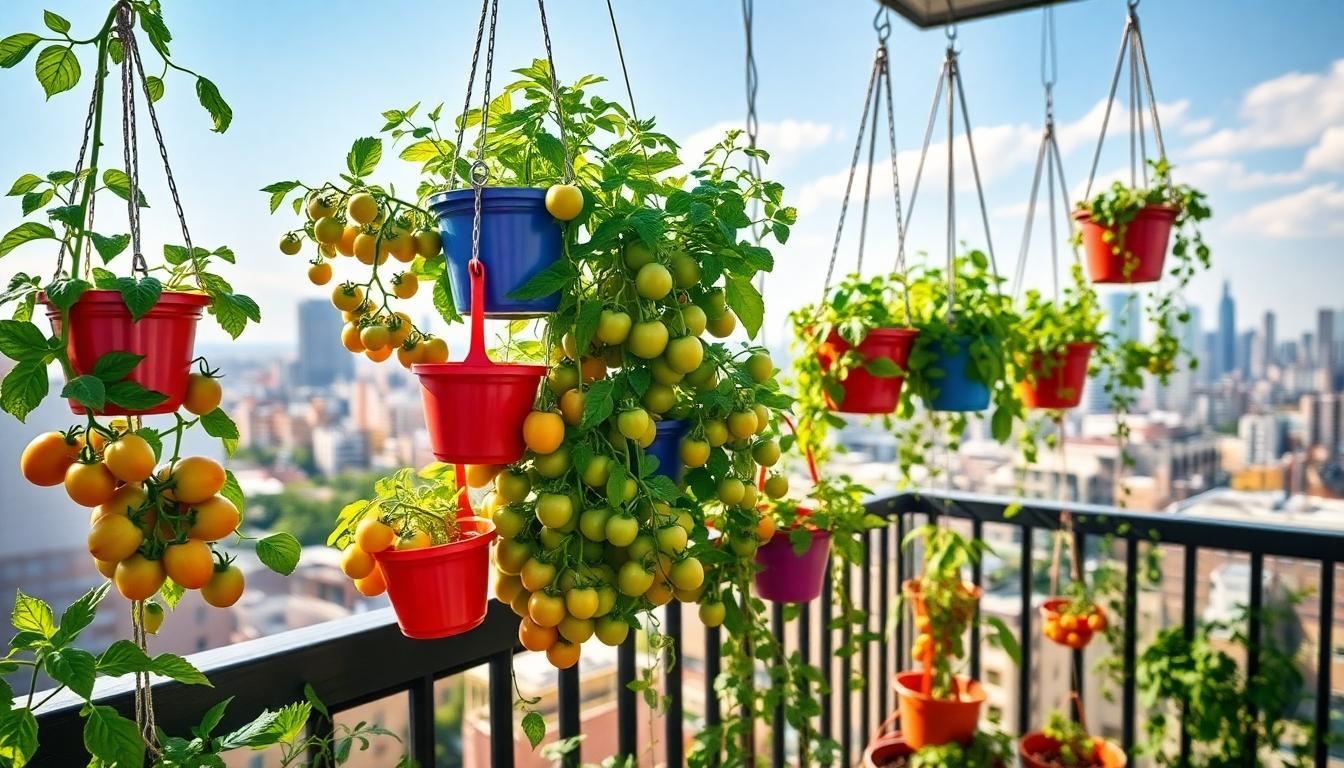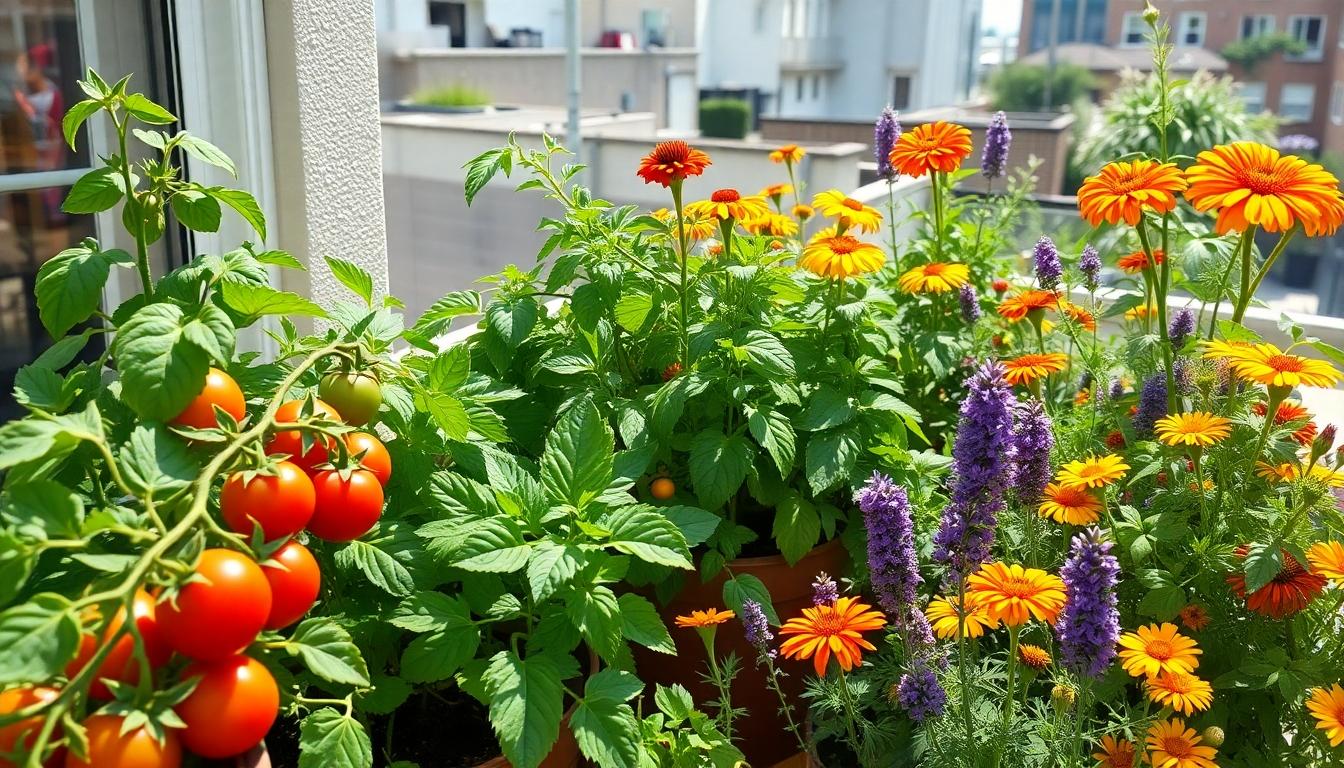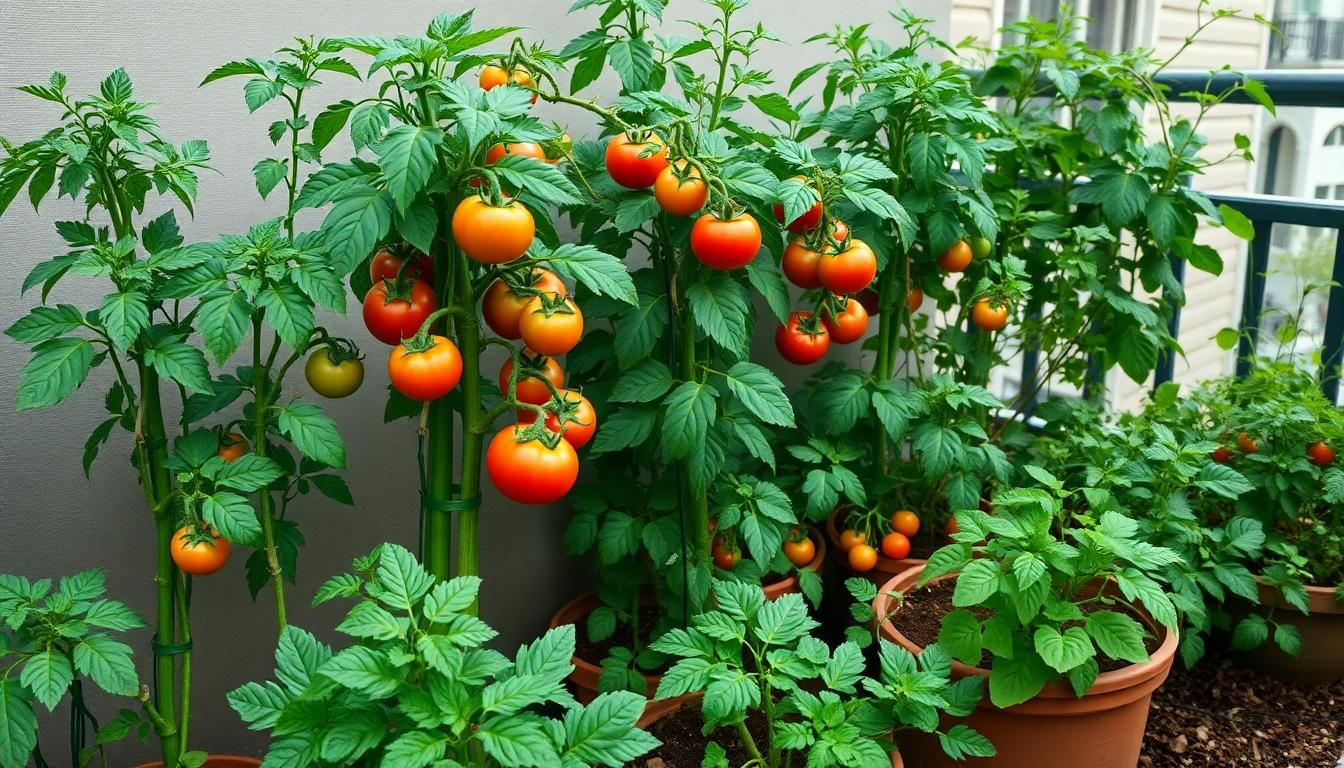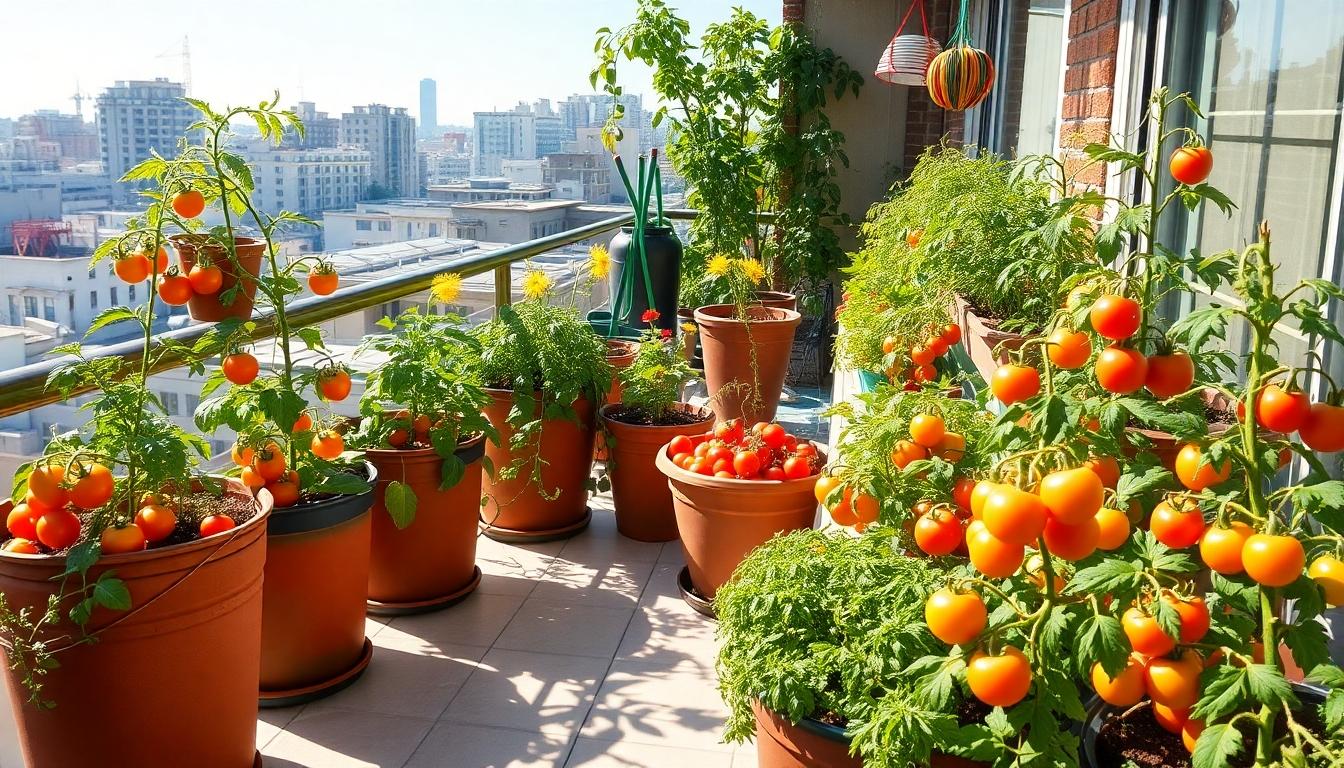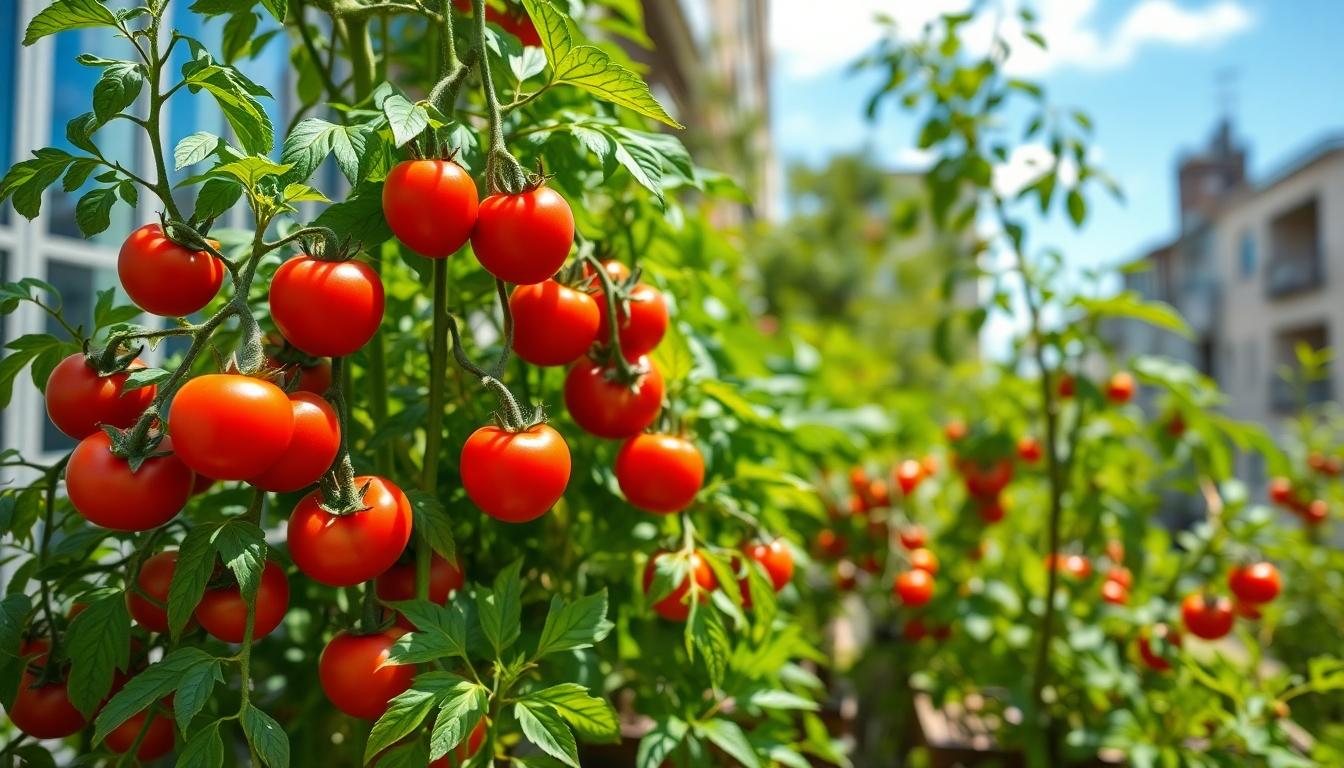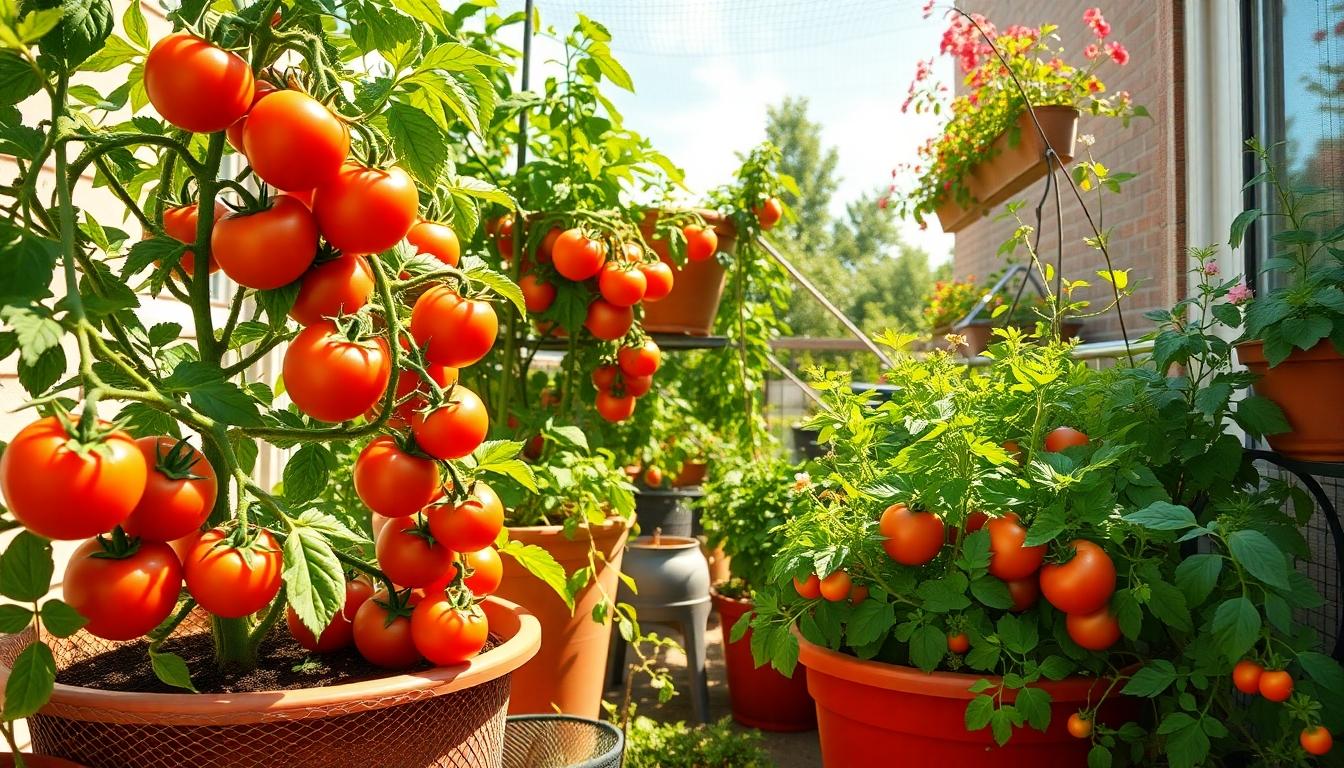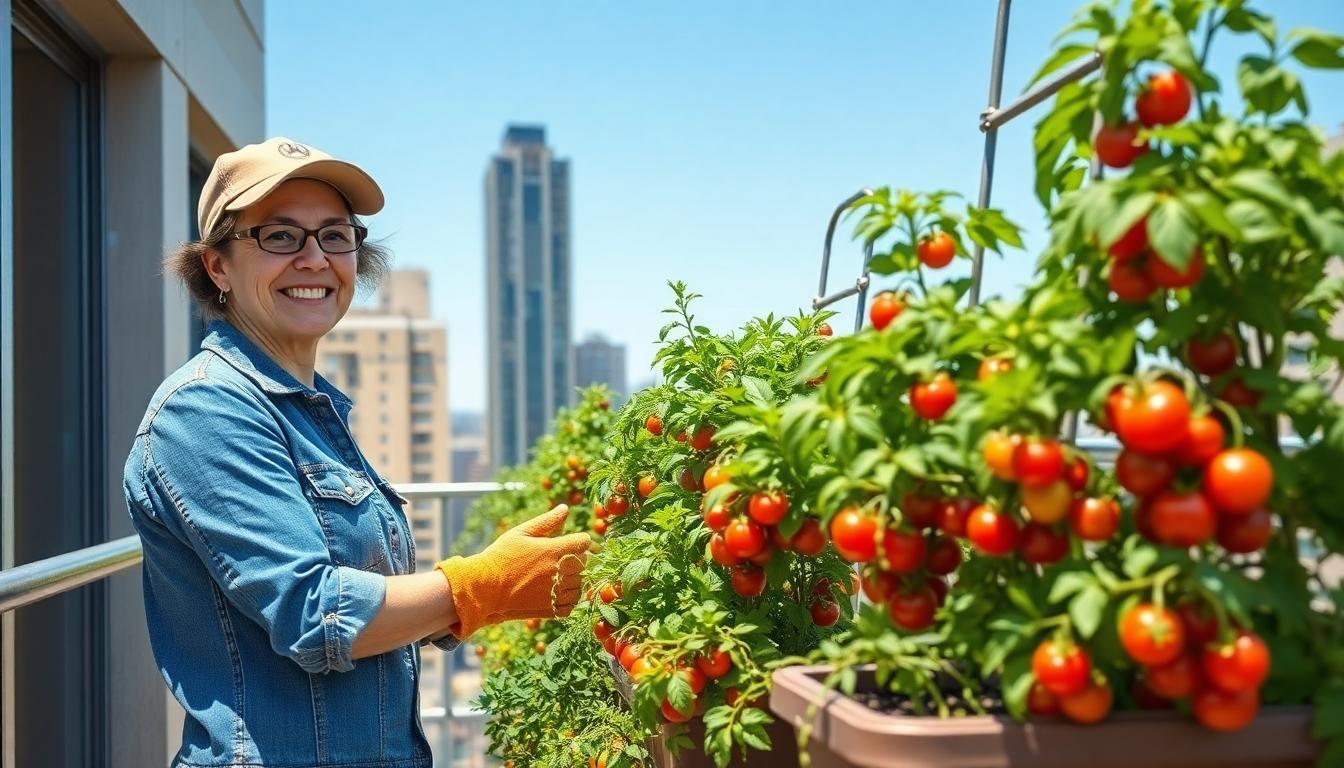Growing tomatoes on your balcony isn’t just practical—it’s downright magical! We’ve discovered that these humble plants can transform even the smallest urban spaces into thriving mini-gardens that yield surprising results. From juicy heirlooms to tiny cherries, balcony tomatoes offer unexpected advantages that many gardeners overlook.
Choosing the Right Tomato Varieties for Your Balcony Garden
Selecting appropriate tomato varieties is crucial for balcony garden success. Not all tomatoes perform well in containers, so choosing varieties specifically adapted to small spaces will significantly impact your harvest.
Compact Varieties That Thrive in Containers
Determinate or bush tomatoes are perfect for balcony gardens due to their compact growth habit. These varieties typically reach only 2-4 feet tall and don’t require extensive staking or caging. Tomato cultivars like ‘Tiny Tim,’ ‘Patio Princess,’ and ‘Bush Early Girl’ produce full-sized fruits while maintaining a container-friendly footprint. Dwarf varieties such as ‘Micro Tom’ and ‘Red Robin’ can grow in pots as small as 6 inches across, making them ideal for narrow balcony railings or small tables. Many container-exact varieties finish their growing cycle faster than traditional garden tomatoes, providing earlier harvests in just 55-65 days from transplanting. Plants labeled as patio tomatoes often feature sturdy stems and reduced leaf coverage, allowing them to withstand wind exposure common on higher balconies.
Unexpected Heirloom Varieties for Balcony Growing
Heirloom tomatoes offer surprising versatility for balcony gardens with their unique flavors and appearances. ‘Purple Bumblebee’ and ‘Green Zebra’ varieties grow remarkably well in containers even though their exotic looks and deliver exceptional taste profiles unlike anything from grocery stores. Container-friendly heirlooms like ‘Stupice’ and ‘Black Prince’ adapt surprisingly well to restricted root spaces while maintaining their rich, complex flavors. Balcony gardeners can experience success with the cascading growth habit of ‘Tumbling Tom’ heirlooms, which spill beautifully over hanging baskets or tall containers. Traditional Italian varieties such as ‘Principe Borghese’ and ‘San Marzano Nano’ have naturally compact growth patterns perfect for container cultivation on balconies. Many lesser-known heirlooms including ‘Mexico Midget’ and ‘Whippersnapper’ produce abundantly on small plants, offering continuous harvests throughout the growing season from a minimal footprint.
Essential Container Gardening Techniques for Balcony Tomatoes
Growing tomatoes on your balcony requires special attention to container gardening fundamentals. The right techniques can dramatically improve your harvest and plant health.
Container Size and Plant Spacing
Selecting pots that are at least 5 gallons in capacity is crucial for optimal tomato growth. These larger containers support faster development and healthier root systems. One tomato plant per pot is the golden rule, as multiple plants will compete for nutrients and result in stunted growth.
Deep planting techniques significantly benefit tomato plants—bury stems up to the lower leaves to encourage robust root systems. This method promotes additional root formation along the buried stem, creating stronger plants.
For indeterminate varieties that continue growing throughout the season, install support structures like cages (at least 38 inches tall) or stakes at planting time. Grouping your containers together serves two important purposes: it shades sensitive root systems from excessive heat and simplifies your watering routine.
Creative Repurposed Container Ideas
Repurposing everyday items for tomato growing can save money while adding unique character to your balcony garden. Five-gallon food-grade buckets with added drainage holes make excellent tomato containers and are often available for free from restaurants and bakeries.
Fabric grow bags offer improved aeration for root systems while being lightweight and reusable season after season. Their breathable material prevents overwatering issues that can plague traditional containers.
Balcony rail planters maximize vertical space by attaching directly to railings, freeing up floor space while positioning plants to receive optimal sunlight. These specially designed containers allow you to grow productive tomato plants even on the narrowest balconies.
Optimal Soil Mixtures for Container Success
Lightweight, sterile potting mixes are essential for container tomatoes, helping to avoid soil-borne diseases that can devastate your plants. Commercial potting soil formulated specifically for vegetables provides the ideal balance of drainage and moisture retention.
Nutrient incorporation through slow-release fertilizer or compost ensures your tomatoes receive continuous feeding throughout the growing season. Proper drainage becomes absolutely critical in container gardening—every pot must have adequate drainage holes to prevent root rot.
Modern potting mixes often eliminate the need for gravel at the container base, though this traditional practice remains optional for gardeners concerned about drainage. Maintaining soil pH between 6.0 and 6.8 creates the optimal growing environment for tomatoes, though high-quality commercial mixes typically provide appropriate pH levels without additional amendments.
Surprising Growth Patterns
Tomato plants often display unexpected growth behaviors in container environments. Plants in large containers can develop surprisingly rapidly compared to garden-grown counterparts when provided with optimal conditions.
Determinate varieties can thrive in smaller 3-gallon containers, making them perfect for limited spaces, while indeterminate types require at least 5-gallon containers to produce heavy yields. Root heat stress—a common problem in containers—can be effectively managed by grouping pots together, creating a cooler microclimate that encourages healthier growth and better fruiting.
Surprising Space-Saving Vertical Systems for Balcony Tomatoes
When space is at a premium, thinking vertically can transform your balcony tomato garden from cramped to thriving. Vertical growing systems maximize your available space while creating an impressive visual display that makes the most of every square inch.
Hanging Basket Innovations
Upside-down tomato planters offer a revolutionary way to grow cherry and small-fruited varieties without sacrificing precious floor space. These hanging systems allow plants to grow downward, making them perfect for balconies where ground space is limited. Many gardeners find that cherry tomatoes thrive particularly well in this inverted position, producing abundant harvests while creating an eye-catching display.
Tiered hanging systems take vertical growing to the next level by stacking multiple baskets in a cascading arrangement. This ingenious approach creates a living wall of tomatoes that can triple or quadruple your growing capacity within the same footprint. The multi-layered design ensures all plants receive adequate light while dramatically increasing your yield potential in even the smallest balcony spaces.
Wall-Mounted Growing Answers
Vertical planters attached directly to walls represent one of the most efficient uses of balcony space for tomato cultivation. These systems come in various materials including wood and plastic, allowing you to choose options that complement your balcony’s aesthetic. Wall-mounted planters can be positioned to maximize sun exposure while keeping valuable floor space free for seating or other uses.
Magnetic plant pockets provide an innovative solution for balconies with metal railings or walls. These clever containers attach magnetically to metal surfaces, turning previously unused vertical spaces into productive growing areas. For extremely compact balconies, this technology allows you to grow tomatoes in spaces you might never have considered usable for gardening.
Innovations in Vertical Farming for Tomatoes
Precision-bred tomato varieties represent a important breakthrough for vertical balcony gardens. These specially developed plants can thrive in vertical systems while producing remarkably higher yields than traditional varieties. Most impressively, these innovative tomatoes can support up to three complete growth cycles annually, giving balcony gardeners the potential for year-round harvests in suitable climates.
Dwarf tomato varieties like ‘Micro Tom’ and ‘Jochalos’ have proven successful in controlled vertical growing environments. These compact plants develop full-sized fruits even though their diminutive stature, making them ideal candidates for space-constrained balcony gardens. Their naturally small growth habit eliminates the need for extensive pruning or support structures, simplifying maintenance while maximizing production in vertical systems.
Unexpected Companion Plants That Boost Tomato Growth
Growing tomatoes on your balcony becomes even more rewarding when you introduce companion plants that enhance growth and protect your precious fruits. We’ve discovered several surprising plant partners that can dramatically boost your tomato harvest in container gardens.
- Radishes serve as excellent tomato companions by breaking up compacted soil in containers, improving overall soil quality for your tomato plants.
- Calendula offers natural pest protection with its strong aroma that deters many harmful insects targeting tomatoes.
- Black-Eyed Peas work as natural fertilizer factories by fixing nitrogen in the soil, providing essential nutrients your tomato plants need for robust growth.
Beneficial Herbs That Deter Pests
Integrating exact herbs into your balcony tomato garden creates a natural pest management system while maximizing your growing space:
- Basil planted alongside tomatoes significantly reduces egg-laying by adult armyworms, protecting your plants from these destructive pests.
- Chives emit compounds that effectively deter aphids, keeping these common tomato pests at bay while adding culinary value to your balcony garden.
- Thyme serves as another powerful deterrent against armyworms, with studies showing reduced insect activity when planted near tomatoes.
Flowers That Attract Pollinators
Adding flowering plants to your balcony tomato containers enhances pollination rates and creates a more balanced growing environment:
- Marigolds attract beneficial insects like bees and hoverflies that increase tomato pollination efficiency while their roots release compounds that deter soil nematodes.
- Lavender brings pollinators to your balcony garden while creating a pleasant aromatic environment that enhances the overall garden experience.
- Nasturtiums function as sacrificial “trap crops” by attracting aphids away from your tomato plants, serving as natural pest management while adding vibrant color to your balcony space.
Weather-Defying Strategies for Balcony Tomatoes
Growing tomatoes on your balcony presents unique weather challenges that can impact your plants’ health and productivity. We’ve compiled effective techniques to help your tomato plants thrive even though challenging weather conditions.
Wind Protection Techniques for High-Rise Gardeners
Wind poses a important threat to balcony tomatoes, especially in high-rise settings. Secure your plants with soft ties or clips attached to sturdy tomato cages to prevent stem breakage during gusty conditions. This simple technique creates a stable growing environment even when facing strong winds. Weighted row covers offer additional protection by creating a barrier against both wind and temperature fluctuations. Place blocks or bricks along the edges of these covers to prevent them from blowing away during unexpected storms. Many balcony gardeners find that strategic placement of containers against walls or corners also creates natural windbreaks that shield delicate tomato plants from damaging breezes.
Temperature Management in Limited Spaces
Balcony tomatoes face extreme temperature challenges due to limited space and increased exposure. Shade cloth provides essential protection during intense summer heat by reducing direct sunlight exposure during peak hours, preventing leaf scorch and fruit damage. Proper mulching maintains consistent soil moisture and moderates temperature fluctuations, keeping roots cooler during heat waves. Ventilation plays a crucial role in temperature management, so arrange containers with adequate spacing to promote air circulation and reduce humidity-related diseases. Deep containers with good drainage and water-catching saucers help maintain optimal moisture levels without temperature extremes. For cold protection, insulated plant protectors like Season Starters use water-filled tubes that absorb heat during the day and release it at night, creating a microclimate that shields tomatoes from frost damage. Lightweight row covers such as Harvest Guard can warm both air and soil temperatures by several degrees, extending your growing season on both ends of the calendar.
Hidden Secrets to Maximizing Tomato Yield in Small Spaces
Growing abundant tomatoes in limited spaces requires exact strategies to unlock their full potential. We’ve discovered that successful balcony tomato gardening starts with ensuring your plants receive at least 6 hours of direct sunlight daily. Pot size matters significantly – always opt for larger containers as they directly support better plant growth and development. For optimal drainage, add a layer of stones or gravel at the bottom of each pot to prevent waterlogging and root diseases.
Pruning Techniques Specifically for Container Plants
Container-grown tomatoes benefit tremendously from strategic pruning to maximize productivity in confined spaces. We recommend regularly removing lower leaves to prevent soil-borne diseases that can quickly spread in container environments. This practice improves air circulation around the plant base, reducing humidity that attracts fungal pathogens. Installing support systems early is essential for indeterminate varieties, as they’ll need sturdy cages or stakes to manage their vigorous growth. Proper support prevents stems from breaking under the weight of developing fruit and keeps foliage off the container soil, further reducing disease risk.
Fertilization Schedules That Produce Remarkable Results
Feeding container tomatoes properly transforms ordinary plants into exceptional producers with impressive yields. We’ve found that applying a balanced fertilizer with equal NPK ratios (20-20-20) during the initial growth phases provides the perfect foundation for healthy development. Switching to a high-phosphorus formula (10-20-10) once flowering begins significantly enhances fruit production and development. Regular watering must accompany your fertilization schedule, keeping soil consistently moist but never soggy to prevent devastating root rot issues. This targeted nutrition approach ensures your balcony tomatoes receive precisely what they need at each growth stage, resulting in harvests that will surprise even experienced gardeners.
Surprising Uses for Your Balcony Tomato Harvest
When your balcony tomato plants start producing more than you can eat fresh, you’ll need creative answers to preserve and enjoy your harvest. These methods help you make the most of every tomato your urban garden produces.
Quick Preservation Methods for Small Batches
Drying tomatoes creates a concentrated flavor bomb that lasts over a year when stored properly in a cool, dark place. Simply slice your tomatoes and use a food dehydrator or oven on low heat until they’re leathery but still pliable. For added flavor, store dried tomatoes in olive oil with herbs, though this shortens their shelf life considerably.
Freezing offers the fastest preservation method for busy urban gardeners. Lay whole tomatoes flat on a tray until frozen solid, then transfer them to freezer bags where they’ll remain safe to eat for at least six months. This method preserves the fresh garden flavor while requiring minimal preparation time.
Canning provides the longest shelf life for your balcony harvest when done correctly. Process quart jars in a water bath for 45 minutes to ensure they’re shelf-stable. Water bath canning works perfectly for acidic tomatoes and requires less specialized equipment than pressure canning methods.
Unique Recipes Showcasing Home-Grown Flavor
Sun-dried tomato tapenade transforms your dehydrated tomatoes into a gourmet spread. Blend your dried tomatoes with olive oil, minced garlic, capers, and fresh herbs to create a versatile condiment that highlights the intense flavor of balcony-grown tomatoes.
Tomato salsa showcases the brightness of fresh-picked tomatoes when combined with onions, jalapeños, cilantro, and lime juice. Your homegrown tomatoes deliver superior flavor compared to store-bought alternatives, making even simple salsa recipes exceptional.
Fermented tomato salsa offers an unexpected twist on traditional recipes. Using the lacto-fermentation process with salt creates a tangy, probiotic-rich condiment that preserves your tomatoes while developing complex flavors. The natural fermentation extends shelf life while improving nutritional benefits.
Pasta with fresh tomato sauce takes just minutes to prepare but delivers restaurant-quality results. Blend ripe tomatoes with garlic, basil, and olive oil for a vibrant, no-cook sauce that tastes remarkably different from commercial versions, highlighting the true essence of garden-fresh tomatoes.
Grilled tomato bruschetta provides a simple yet impressive appetizer option. Top toasted bread with diced tomatoes, fresh basil, and mozzarella for a dish that lets your balcony harvest shine. The natural sweetness of homegrown tomatoes elevates this classic Italian starter to new heights.
Common Balcony Tomato Problems and Their Unexpected Solutions
Growing tomatoes on a balcony offers incredible rewards, but it also comes with unique challenges that require innovative answers. We’ve identified the most common issues that balcony gardeners face and developed unexpected fixes that will transform your tomato-growing experience.
- Lack of Sunlight: Tomatoes require at least 6 hours of direct sunlight daily to produce healthy fruit. Repositioning containers to maximize sun exposure can make a important difference in plant productivity. For severely light-limited balconies, installing grow lights provides the supplemental illumination needed for robust growth.
- Insufficient Air Flow: Poor circulation between plants creates the perfect environment for fungal diseases to flourish. Proper spacing between containers prevents this issue by allowing air to move freely around foliage. Regular pruning of lower leaves improves ventilation and reduces humidity levels that promote disease development.
- Watering Inconsistencies: Both overwatering and underwatering create stress that impacts fruit production. Directing water to the soil at the base of plants rather than spraying leaves from above prevents fungal problems. Consistent moisture levels support continuous fruit development throughout the growing season.
Natural Pest Management Without Chemicals
- Physical Barriers: Fine mesh netting creates an effective defense against flying insects without hindering plant growth. These lightweight barriers prevent pests from reaching your tomato plants while still allowing sunlight, water, and air to penetrate freely.
- Beneficial Insect Attraction: Ladybugs and lacewings serve as natural predators that control aphid populations on your tomato plants. Incorporating small flowering plants like sweet alyssum between containers attracts these helpful insects to your balcony garden.
- Homemade Organic Repellents: Garlic spray produces a potent odor that deters various pests while remaining harmless to plants and humans. Neem oil applications disrupt the life cycles of multiple insect species without introducing harmful chemicals. Chili pepper answers create an unpleasant environment for soft-bodied pests that might otherwise damage your tomato plants.
Troubleshooting Container-Exact Growing Issues
- Root Bound Plants: Container-grown tomatoes frequently become root bound when pots are too small. Using containers with at least 7-gallon capacity ensures adequate room for proper root development. Deep containers providing over 12 inches of soil depth support extensive root systems that access more nutrients and water.
- Nutrient Deficiencies: Blossom end rot appears as dark, sunken areas on tomato fruits due to calcium deficiency. Soil testing identifies exact mineral shortages before they cause extensive damage. Applying amendments like lime or gypsum addresses calcium issues to prevent fruit deformities and improve overall plant health.
- Temperature Fluctuations: Balcony environments often experience extreme temperature changes that stress tomato plants. Thermal masses like water-filled containers placed near pots help regulate temperature by absorbing heat during the day and releasing it at night. Insulating pots with bubble wrap or specialized pot covers protects roots from rapid temperature shifts that can stunt growth or damage plants.
Amazing Success Stories: Balcony Tomatoes That Defied Expectations
Urban gardeners across the country have achieved remarkable success with balcony tomatoes, often surpassing what many thought possible in container gardening. These success stories prove that limited space doesn’t mean limited harvests.
One impressive example comes from a gardener who harvested approximately 20 pounds of Cherokee Purple tomatoes from a self-watering planter with a trellis on their deck. Even though starting late in the growing season and facing limited pollinators, they achieved this bountiful yield with minimal effort. In Raleigh, NC, another determined grower cultivated a veritable forest of tomato varieties in containers and grow bags on a driveway, demonstrating that substantial yields are absolutely possible in small spaces with proper dedication.
Perhaps most inspiring is the story of a Washington, D.C. resident who successfully grew cherry tomatoes on a tiny, north-facing balcony about 60 feet high for over a decade. Their experience proves that even less-than-ideal conditions can produce heavy fruit loads when using appropriate varieties and container setups.
Urban Gardeners Who Broke Yield Records
Container size plays a crucial role in breaking yield records for balcony tomatoes. Successful urban gardeners typically use large containers measuring at least 14 to 20 inches in diameter or holding a minimum of 5 gallons of soil. These spacious containers provide ample room for root growth, significantly reducing common problems like blossom end rot and water stress that plague container tomatoes.
Consistent fertilization represents another key factor in record-breaking yields. Top performers carry out calcium-rich nutrients and balanced feeding regimes throughout the growing season. This regular nutrition ensures plants maintain vigorous growth and fruit production even in limited soil volumes.
Variety selection greatly impacts yield potential on balconies. Cherry tomatoes and medium-sized varieties like Cherokee Purples consistently outperform larger beefsteak types in containers. These smaller fruited plants cope better with container constraints while still delivering impressive harvests that defy expectations for urban growing spaces.
Innovative Approaches That Changed Container Gardening
Self-watering planters with built-in reservoirs and trellises have revolutionized balcony tomato growing. These innovative containers simplify watering and provide built-in support for growing plants, reducing maintenance efforts while maximizing yields. Many gardeners report maintaining healthy plants with these systems even during periods when they couldn’t water daily.
Hanging containers offer another game-changing approach for balcony gardeners. These space-optimizing answers protect plants from ground-dwelling pests while utilizing vertical space efficiently. Even on the smallest balconies, hanging systems allow gardeners to grow productive tomato plants without sacrificing valuable floor space.
Custom potting soil blends have transformed container growing success rates. Forward-thinking gardeners create specialized mixes enriched with compost and calcium supplements to ensure optimal nutrient availability and prevent blossom end rot in limited soil volumes. These customized soil formulations address the unique challenges of container growing environments.
Hand pollination techniques provide essential support for fruit set in urban environments where natural pollinators may be scarce. Innovative gardeners use small brushes or gentle tapping methods to ensure flowers pollinate properly, dramatically increasing yield potential on high-rise balconies or in areas with limited insect activity.
Specialized tomato varieties bred specifically for container growth represent perhaps the most important innovation. Compact cherry tomatoes and container-exact cultivars offer prolific yields even in restricted environments. These plants make efficient use of limited root space while producing surprisingly abundant harvests throughout the growing season.
Seasonal Planning for Year-Round Balcony Tomato Harvests
Growing tomatoes on your balcony isn’t just a summer hobby—it’s a groundbreaking gardening experience that yields incredible rewards. We’ve seen how even the smallest spaces can produce abundant harvests with the right varieties techniques and companion plants.
The journey from selecting compact varieties to implementing vertical answers reveals that balcony tomatoes aren’t limited by space but enhanced by creative approaches. With proper container selection nutrient-rich soil and strategic positioning you’ll be amazed at how productive your urban garden can become.
Remember that each balcony presents unique growing conditions. By adapting to your exact environment and implementing the strategies we’ve shared you’ll turn your ordinary balcony into an extraordinary tomato haven that delights both the eye and the palate season after season.
Frequently Asked Questions
What are the best tomato varieties for balcony gardening?
Compact varieties like determinate or bush tomatoes are ideal for balconies. ‘Tiny Tim’, ‘Patio Princess’, ‘Purple Bumblebee’, and ‘Stupice’ perform exceptionally well in containers. These varieties produce full-sized fruits without requiring extensive support systems and adapt well to limited root space, making them perfect for small urban spaces.
How large should containers be for growing balcony tomatoes?
Containers should have a minimum capacity of 5 gallons to support healthy root systems. Larger pots (10-15 gallons) facilitate better growth and yield. Plant only one tomato per container to prevent nutrient competition. Deep planting encourages robust root development, while proper drainage is essential for preventing waterlogging and root rot.
What soil mixture works best for container tomatoes?
Use lightweight, sterile potting mix specifically designed for containers. The ideal mix includes perlite or vermiculite for aeration, coco coir or peat moss for water retention, and compost for nutrients. Incorporating slow-release fertilizers at planting time provides sustained nutrition. Avoid garden soil in containers as it compacts easily and may contain pathogens.
How can I maximize space for tomatoes on a small balcony?
Implement vertical gardening techniques like upside-down planters, tiered hanging systems, wall-mounted planters, and magnetic plant pockets. These space-saving solutions utilize vertical surfaces while keeping floor space free. Precision-bred dwarf varieties like ‘Micro Tom’ and ‘Jochalos’ are perfect for compact vertical systems, offering good yields in minimal space.
What companion plants benefit tomatoes in container gardens?
Plant radishes to improve soil quality, calendula for pest protection, and black-eyed peas as natural fertilizers. Herbs like basil, chives, and thyme help deter pests while improving tomato flavor. Flowering plants such as marigolds, lavender, and nasturtiums attract beneficial pollinators and create a balanced growing environment that enhances tomato health and productivity.
How can I protect balcony tomatoes from wind and extreme temperatures?
Secure plants with soft ties and use weighted row covers for wind protection. For temperature management, install shade cloth during intense heat and apply mulch to maintain soil moisture. Arrange containers to optimize ventilation and use insulated plant protectors during cold periods. Creating a microclimate by grouping containers helps regulate temperature and extends the growing season.
What’s the minimum sunlight requirement for balcony tomatoes?
Tomatoes need at least 6 hours of direct sunlight daily for optimal growth and fruit production. If your balcony has limited sun exposure, choose varieties bred for partial shade tolerance, like ‘Glacier’ or ‘Stupice’. Repositioning containers throughout the day to follow the sun pattern can significantly improve light exposure and boost yield.
How should I fertilize balcony tomatoes for maximum yield?
Apply a balanced fertilizer (like 10-10-10) during initial growth stages. Switch to a high-phosphorus formula (like 5-10-10) when flowering begins to boost fruit production. Follow a bi-weekly feeding schedule, reducing to monthly during peak fruiting. Liquid fertilizers provide immediate nutrition, while slow-release granules offer sustained feeding for consistent growth.
What are effective ways to preserve my balcony tomato harvest?
Quick preservation methods include drying (for concentrated flavor), freezing (whole or pureed), and water bath canning (for sauces). Try making sun-dried tomato tapenade, fresh tomato salsa, fermented tomato salsa, homemade pasta sauce, or grilled tomato bruschetta. These preservation techniques and recipes help you enjoy your harvest long after the growing season ends.
How do I troubleshoot common balcony tomato problems?
For insufficient sunlight, reposition containers to maximize exposure. Ensure proper spacing for adequate air circulation to prevent disease. Water at the soil base to maintain consistent moisture. For pest management, use physical barriers, attract beneficial insects, or apply homemade organic repellents. Address container-specific issues like root-bound plants by repotting and correct nutrient deficiencies with appropriate fertilizers.


